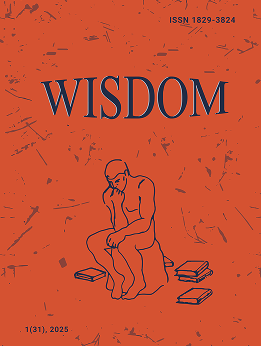Raphael‟s “The School of Athens”: A Hypothesis on the Identity and Symbolic Meaning of the Figure in White Cloak: The True Muse of Raphael
DOI:
https://doi.org/10.24234/wisdom.v26i2.1006Keywords:
Raphael, “The School of Athens”, Francesco Maria della Rovere, Imperia, Raphael’s Muse, Margherita Luti, “Four Sibyls”Abstract
Raphael’s fresco “The School of Athens” is rich with figures of prominent philosophers who are identified by their certain characteristic details. The identity of a figure in Raphael’s “The School of Athens” Plato group traditionally attributed to Francesco Rovere, is currently being questioned. Present article brings forward a new hypothesis on this matter: the aforementioned figure is seen as a collective figure that symbolizes the unity of a man and a woman, in this case, Raphael and his muse. Besides, this figure also encodes the year when the fresco was painted. As a key to the code, the blackboard containing the Platonic perfect number 10 immediately at the figure’s feet is important, as well as the positions of some of the figures in the first row on the left part of the painting. The article also makes some revelations about Raphael’s real muse, who, according to the author, was the courtesan Imperia. Evidence of this is the fact that Imperia is portrayed in many of Raphael’s works.
Downloads
References
Becherucci, L. (1969). Raphael and painting. In M. Salmi (Ed.), The Complete Work of Raphael (pp. 9-198). Harrison House.
Benediktov, A. (2006). V kommentariyakh vizni Rafaelq Dzh. Vazari (In endnotes of G. Vasariís Life of Raphael, in Russian). In A. Benediktov, & A. Gabrichevski (Eds., Trans.), Zhizneopisaniya Znamenitikh Zhivopistsev (Lives of most excellent painters, in Russian) (pp. 77-136). Saint Petersburg: Azbuka-Klassika.
Cocke, R., & Vecchi, P. (1966). The complete paintings of Raphael. New York: Harry N. Abrams Inc. Publishers.
King, R. (2003). Michelangelo and the Popeís ceiling. Walker&Co.
Lubke, W. (1878). Geschichte der Italienischen Malerei. (2nd Bd.). Ebner&Seubert.
Plato (2008). Symposium. Cambridge University Press.
Servadio, G. (2005). Renaissance woman. I. B. Tauris. Bloomsbury Publishing. DOI: https://doi.org/10.5040/9780755695164
Stein, W. (1923). Raffael (Raphael, in German). Georg Bondi.
Wolfflin, H. (1952/1899). Classic art, an introduction to the Italian Renaissance (P. & L. Murray, Trans.). Phaidon Press.
Downloads
Published
How to Cite
Issue
Section
License
Copyright (c) 2023 Vahan Bezirganyan

This work is licensed under a Creative Commons Attribution-NonCommercial 4.0 International License.
Creative Commons Attribution-Non-Commercial (CC BY-NC). CC BY-NC allows users to copy and distribute the article, provided this is not done for commercial purposes. The users may adapt – remix, transform, and build upon the material giving appropriate credit, and providing a link to the license. The full details of the license are available at https://creativecommons.org/licenses/by-nc/4.0/.















